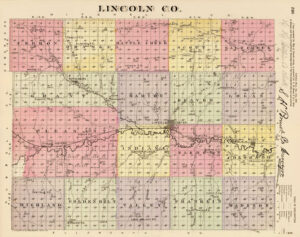Rocky Hill, Kansas, is an extinct town in Lincoln County. It was built near the site of another extinct town called Abram.
A man named Hyatt operated a sawmill below Rocky Hill in 1867 and sawed lumber which was transported to what is now Kanopolis, Kansas, where the government built Fort Harker.
On January 19, 1871, Myron D. Greene bought a quarter section of railroad land from the Union Pacific Railroad Company about three miles southeast of the present site of Lincoln. He soon had it surveyed by O.P. Hamilton of Salina, Kansas, and laid off the land into town lots. It consisted of 36 blocks that included a public square, and one-quarter of a block was set aside for different churches — Presbyterian, Methodist, Baptist, and Catholic.
South of Rocky Hill was a boundless prairie with a line of trees marking the Saline River. To the east was Beaver Creek.
O.N. Greene supervised the work on every building erected on the townsite. Myron Greene built the first building, a 25 by 60 feet structure that was one and one-half stories high. The first floor was used for a general store and post office, while the upper story was used for community gatherings.
Other buildings erected on the townsite were Dr. Gilpin’s office and residence; a newspaper office building built for the Lincoln County Gazette but only one issue was printed; Peter Eldredge’s shoe shop, Hezekiah Graham’s Hotel, Ellen Osborne’s boarding house; Harlow Walker’s blacksmith shop, Buckner’s Saloon, and about half dozen or more houses. An open well with an old oak bucket furnished the town with water.
On April 4, 1871, a post office was moved from Red Rock to Rocky Hill.
The most important industry in Rocky Hill was the Hubbard Mill, which was commenced in 1871 by Ezra Hubbard, and was the first mill in the county. It contained three runs of burrs and was valued at $7,000. People came from miles around to the grist mill to have their grain ground into flour, for which they gave a percentage of their grain as a toll to pay for the grinding. Trade was centered around the mill, and several stores and numerous dwellings were built. Upon the death of Hubbard, Charles Bennett operated the mill for a short time. He sold the mill to a man named Hense, who, in partnership with his boys in after months, sold it to Hugh Graham Sr., who operated it until he died in 1891. Soon after his death, it was torn down.
School District No. 3, known as Rocky Hill, was organized in 1871, and bonds were voted to build a school. However, the school was held in the upper story of Myron D. Green’s store the first year with J.H. Barnum as the teacher. Church services for all demonization were also held in the second story of Myron Greene’s store. Upon completing the school building, Jennie Pier was hired as the teacher. Church services were also moved to the school.
M.M. Stearns operated a drug store; Herman Schmidt, a blacksmith shop; and Merriman, a general merchandise store.
On February 19, 1872, the voters voted 232 to 176 to move the county seat from nearby Abram to its present location in Lincoln.
On February 26, 1872, the post office was moved from Rocky Hill to Abram. However, it wouldn’t stay there long, as it was moved back to Rocky Hill on December 5, 1872. Mail came three times a week overland from Salina by stagecoach. Royal Callins drove the stagecoach for several years until the coming of the railroad in 1886.
Afterward, many of Abram’s buildings were either moved away or torn down, and Rocky Hill became the trading center for the area. Harlow Walker’s blacksmith shop in Abram was moved to Rocky Hill, where Herman Schmidt did blacksmith work for many years.
However, its close proximity to Lincoln Center would lead to its demise. Rocky Hill’s post office closed on August 30, 1880.
Afterward, Buckner’s Saloon, the first in the county, was moved to Lincoln and subsequently burned down. Hezekiah Graham’s hotel, known as the Bee Hive, was moved to Lincoln and housed John Kyle’s tin shop for many years. Ellen Osborne’s boarding house was moved and later occupied by the Lincoln Body and Fender Works. It was also used as a blacksmith shop for many years before it was torn down, and the lot was occupied as a used car lot. E.B. Bishop’s two-room frame building residence was also moved to Lincoln. Myron Greene’s store was sold to Alonzo Allison and moved to a farm two miles east of where Abram stood.
In 1910 the school was moved a half mile to the west, serving the community until 1950, when the district consolidated with District No. 6.
©Kathy Alexander/Legends of Kansas, July 2023.
Also See:
Extinct Towns of Lincoln County
Sources:
Blackmar, Frank W.; Kansas: A Cyclopedia of State History, Vol I; Standard Publishing Company, Chicago, IL 1912.
Cutler, William G; History of Kansas; A. T. Andreas, Chicago, IL, 1883.
Kansas GenWeb
Lincoln Sentinel-Republican, September 8, 1955

